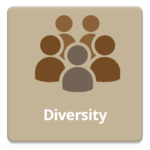 What is Diversity?
What is Diversity?
Definitions
These definitions of diversity, equity, and inclusion are taken directly from Independent Sector:
Diversity includes all the ways in which people differ, encompassing the different characteristics that make one individual or group different from another. While diversity is often used in reference to race, ethnicity, and gender, we embrace a broader definition of diversity that also includes age, national origin, religion, disability, sexual orientation, socioeconomic status, education, marital status, language, and physical appearance. The Independent Sector definition also includes diversity of thought: ideas, perspectives, and values. They also recognize that individuals affiliate with multiple identities.
Equity is the fair treatment, access, opportunity, and advancement for all people, while at the same time striving to identify and eliminate barriers that have prevented the full participation of some groups. Improving equity involves increasing justice and fairness within the procedures and processes of institutions or systems, as well as in their distribution of resources. Tackling equity issues requires an understanding of the root causes of outcome disparities within our society.
Inclusion is the act of creating environments in which any individual or group can be and feel welcomed, respected, supported, and valued to fully participate. An inclusive and welcoming climate embraces differences and offers respect in words and actions for all people. It’s important to note that while an inclusive group is by definition diverse, a diverse group isn’t always inclusive. Increasingly, recognition of unconscious or ‘implicit bias’ helps organizations to be deliberate about addressing issues of inclusivity.
Watch CASA Training Manager, Ann Marie Ronsman, and CASA Executive Director, Ann McAlpin, launch the first drip training video and explain the importance of diversity and inclusion to volunteers as they advocate for children.
Continuing education Resources:
The Hundred Dollar Race
Summary: Video that visually shows how all of us don’t have the same start in life.
Implicit Bias
Summary: Article that talks about how we all have some bias we are not aware of. READ NOW
Unconscious Bias
Summary: This animation introduces the key concepts of unconscious bias. It helps bring awareness to differences in how people may present themselves, how to recognize bias in yourself and others, how to recognize inappropriate advocacy or unreasoned judgement. You can find out more about unconscious bias and download a briefing which includes current academic research at www.royalsociety.org/diversity.
Sex Trafficking in Foster Care
Summary: Article about sex trafficking in foster care in Texas from the perspective of a child. READ NOW
What is Islam
Summary: Video about the basic tenants of Islam.
LGBTQ
Summary: Video about growing up LGBTQ in Texas foster care.
Foster Youth Video – How Foster Care Can Be a Stepping Stone
Summary: After being taken from her adopted parents, Kaysie, a former foster youth shares her experiences living in twelve different placements from the time she was 14 until she aged out at 21.
African american children in travis county – 8 times more likely to be removed by CPS
Summary: African-American children in Travis County were nearly eight times more likely to be removed from a home by Child Protective Services than white children during the year ending Aug. 31, according to new state data. Black children in Travis County also were 4.6 times more likely to be reported to CPS as victims of possible abuse and neglect than their white peers and 5.1 times more likely to be investigated by CPS. The disparities in Travis County are the highest among the state’s seven largest counties, a recent report by the Texas Department of Family and Protective Services found. As advocates we need to be asking objective questions about our cases, keeping in mind that it is possible for racial disparities to exist in the child welfare system. READ NOW

